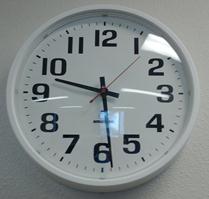Analog Clocks: My Generation’s Slide Rule

A couple weeks ago I was sitting in our psychology lab when a student wandered in.
Me: Can I help you?
Student: <locating the clock on the wall> I was wondering what time it is.
The student is visually impaired, judging by how close he was standing to the clock and how he was squinting.
Me: It’s 20 ’til 11.
Student: What?
Thinking the student is also partially deaf, I speak up.
Me: IT’S 20 ‘TIL 11.
Student looks at the clock, clearly baffled. Another student in the lab chimes in.
Student #2: It’s 10:40.
Student: Oh! I’m late!
Finally it dawns on me. The student didn’t know how to read an analog clock. He wasn’t a young student, either; probably in his thirties. I mentioned this to a colleague who has a teenage daughter. He said that she also can’t read an analog clock. Although he wasn’t entirely convinced she could tell time at all judging by her inability to be on time. There are some confounding variables there, granted.
One week later I’m back in the lab when another student wanders in; this one is younger. I’m thinking, “Here we go again.”
Me: Can I help you?
Student: <locating the clock on the wall> I just wanted to know what time it is.
Student stares at the clock.
Student: <wanting to give it a try> It’s 9… no, it’s 10… 10…
Me: 10:40.
Student continues to stare at the clock not quite believing me.
Me: It’s actually 10:37.
Satisfied, the student walks out.
[Side note: Weirdly, both of these events did take place at 10:40-ish.]
Now I’m not curmudgeonly enough to say that everyone should know how to read an analog clock. In our digital world, it doesn’t matter. Slide rules were very useful right up until calculators became small enough and cheap enough for most everyone to have. It’s been years since I had an analog watch, or a watch of any kind for that matter; the digital display on my cell phone works just fine when I’m on the go. When I’m in my office, my computer provides a nice digital readout in the bottom right corner.
A few colleagues and I were discussing this phenomenon recently. One person wondered what that was going to do to the concepts of clockwise and counterclockwise. Will the terms disappear or will they continue to be used but with their origin largely forgotten, like “the whole nine yards”? Apparently it’s becoming something of an issue because I noticed the recent addition of helpful arrow icons to Adobe Reader. Maybe in the end it will just be “rotate right” and “rotate left”.

Another colleague wondered what will happen to “the top of the hour.” That one may hang on with its origins eventually lost, but I’d say that the days are numbered for “quarter past” and “quarter ’til”. “Half past” may also be doomed.
If you’re feeling adventurous, show your students a few images of an analog clock and ask them to write down what time the clock is showing. I’d be curious to hear how many can do it. Post your results in the comments below.